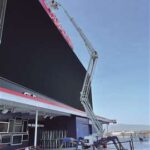Learn How to Charge a Scissor Lift: A Quick Guide
Charging Time for Scissor Lifts
Charging a scissor lift properly is essential for safe operation. To ensure you’re following best practices, consider enrolling in an OSHA-approved scissor lift certification course. It covers everything from proper charging techniques to the latest safety protocols, helping your team stay compliant and avoiding costly fines.
Tips for Charging a Scissor Lift Safely
-
Park the Lift
Ensure the lift is in a well-ventilated area with easy access to an electrical outlet. -
Turn Off the Lift
Power off the machine and activate the emergency shut-off to prevent accidental movement. -
Connect the Charger
Locate the battery charger (usually on the right side or rear) and plug it into an AC extension cord, then connect it to a power outlet. Keep the cord short to avoid accidents. -
Check the Charger
Ensure the charger light is on. Once fully charged, the light will turn green, and the charger will automatically shut off. -
Unplug When Done
Disconnect the charger once the lift is fully charged.
Frequently Asked Questions
How Long Does a Scissor Lift Take to Charge?
Charging time can range from 6 hours for some models to 12-16 hours for others. If you need to use it while charging, take precautions to avoid accidents.
How Long Do Batteries Last?
Battery life depends on usage but typically lasts 6-48 months. Regular maintenance can extend their life.
Can You Use a Generator to Charge?
Yes, a generator can be used if there’s no available power outlet. Ensure safety precautions are followed.
What if the Lift Won’t Charge?
If charging fails, try using a 6v charger to boost the voltage. Consult the manual or manufacturer if issues persist.
How Many Batteries Does a Scissor Lift Need?
Most lifts use four 6v batteries, with larger models requiring eight. Always follow the manufacturer’s guidelines for battery specifications.




